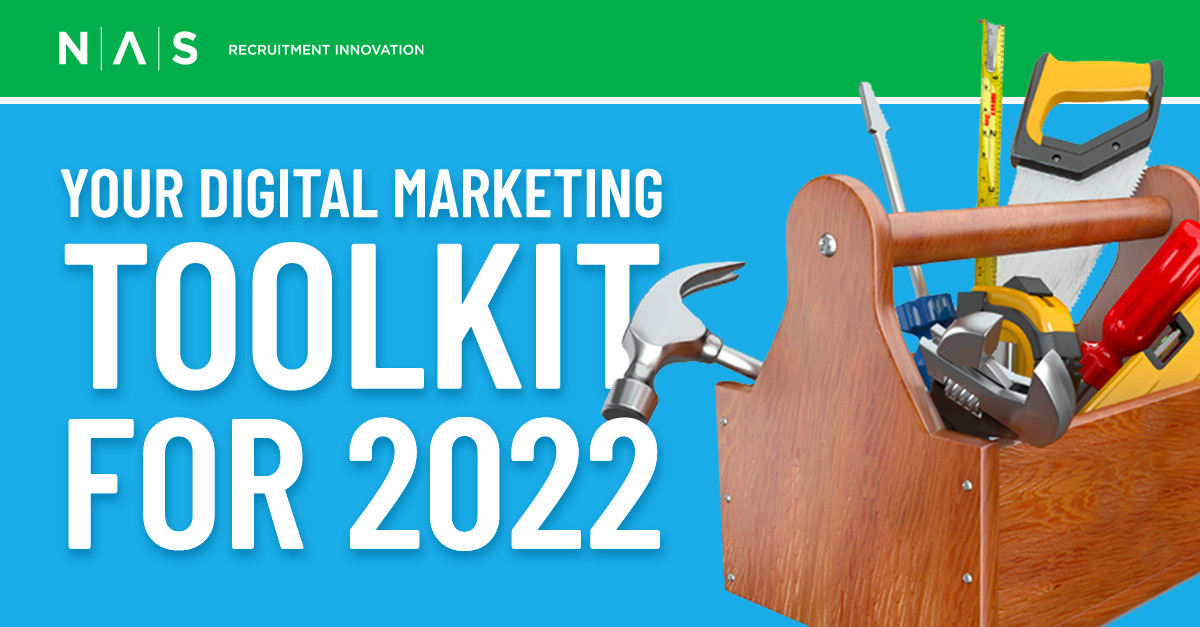-
The power of Digital Marketing – Top Trends for your 2022 Recruitment Toolkit
Posted by Ina Kobilis on January 13th, 2022 
Attracting and hiring talent has been challenging over the past 18 months to say the least. The pandemic has prompted many employees to hit the reset button. When working from home became the norm during the first months of the pandemic, employees began reevaluating their general work status. Many even decided to resign.
Resignations peaked in April of 2021 and have remained abnormally high for the past several months, with a record-breaking 10.9 million open jobs at the end of July (Harvard Business Review). Dubbed “The Great Resignation” by the media, this was just one of several notable trends that evolved in 2021.
Hourly workers also seem to be reevaluating their priorities, with more than half of them (52%) actively looking for a new job, according to Nexxt.
And while workers and employees are quitting their jobs at higher-than-usual rates now, 76% of companies predict that hiring demand will approach, return to, or even exceed pre-pandemic levels in 2021 (Careerarc, 2021).
The best way to meet that demand and to stand out against the competition is to make sure you are leveraging your digital marketing toolkit at its full potential and to be aware of all upcoming trends.
NAS can help by identifying and setting up the right digital advertising strategy for your hiring needs.
Let’s look at the most common and most effective digital advertising approaches and new trends that are evolving around these methods.
- Search Advertising
When it comes to digital marketing, Google Search Advertising is most essential to your recruitment marketing strategy. 90% of candidates begin their job search on Google and on average, more than 50% of clicks on Google go to one of the top 3 results/ads. Setting up a Google Search campaign starts with identifying the right keywords to advertise your open positions to help them stand out to both active and passive job seekers. Every time a user clicks on your ad you pay a cost-per-click (CPC). You can choose to set a maximum amount you are willing to pay per user click or you can let Google optimize the CPC automatically. A Google Paid Search campaign can place your job openings in front of a very specific or a very broad audience, depending on your hiring needs. In any case, it is estimated that 89% of traffic delivered by a paid search campaign would not have visited the site without that campaign.
- Display Advertising
Like search advertising Google Display Advertising also increases the visibility of your website and job openings – but with the advantage of using imagery to capture the candidate’s attention. Images are beneficial in building awareness for, and supporting, your Employer Brand. When running a Google Display campaign, paid banner ads are being placed on third-party websites based on keywords and context, putting your company in front of a rather passive but very desirable audience.
Trend 2022: Both Google Search and Display Advertising will benefit from the increasing use of AI in the coming years, predicting keywords that candidates search for even more accurately.
- Retargeting
It is proven that 25% or less of candidates apply on their first visit. Re-engaging users who have previously interacted with one of your job postings or who have visited your career site is usually less expensive than targeting new leads. Retargeting uses display banner advertising to target users who have visited or navigated through your website or social media platforms before. If the candidate didn’t convert – meaning they didn’t complete the application – these banner ads will follow them throughout the internet, keep your company present in their mind and eventually pull them back to complete the application.
To enable retargeting, tracking tags will be placed on desired landing pages (e.g., career site, certain job postings, etc.). Once a candidate visits these pages, they are “tagged.” If they do not convert and leave your website, they will then begin seeing your banner ads on other websites they visit.
By leveraging a combination of all three methods described above, NAS was able to help one of its clients – Cardinal Health – to generate more than 700 apply starts in a very short amount of time for its warehouse worker positions in a highly competitive market.
- Geofencing
This method uses real-time location-based technology and lets you create a “virtual fence” around an actual, physical location. You can target users that enter and move around within the area you specified – not only with ads but also with push notifications and text messages. This proves incredibly helpful if you are looking to attract candidates from a certain college, at a conference or job fair or even near a competitor location. Rather than sending out mass advertisements, geofencing gives you the opportunity to personalize your ads and messages – e.g., by mentioning the college or the event the potential candidate is attending.
Trend 2022: Although this isn’t a new trend, it is becoming increasingly relevant – Mobile First Marketing. Over the last few years, the way users access the internet has shifted from desktop computers to mobile devices. Making sure your ads are created with a mobile first approach is key in delivering the best user experience and optimizing your campaign success.
- Social Media Advertising
Social Media has become an integral part of our everyday lives from the moment we wake up and check our phone until the moment we fall asleep at night. Although other platforms are gaining in popularity, Facebook remains the platform where people spend much of their social media time each day. Running a Facebook promoted post campaign can therefore be highly effective in reaching your desired audience in a more personal environment. The promoted post ads lead the user to your application with buttons that suggest the candidate “learn more” or “apply now.” An excellent method of reaching your passive jobseeker and building brand awareness is Facebook Advertising. Here, you can use appealing images or a video, clear messaging, interest-based targeting and direct call-to-actions. NAS usually recommends using a “Link Click Ad” – one of the many different ad formats Facebook is offering – since it is supported by Facebook and Instagram, thus targeting two different audiences on two different platforms at the same time.
Using this approach, NAS was able to help its client ROSS run a successful campaign to hire Retail Associates for positions at stores across the country. Both the CTR (click-through-rate) and the CPC surpassed industry averages and the candidate engagement on the campaign were high.
As Account Director at NAS Recruitment Innovation, I usually recommend starting with a broad digital campaign setup, looking into all the five methods mentioned above, so you are not missing any opportunities to reach active job seekers as well as passive candidates. Once you have identified methods that work better for certain positions, you can optimize and shift budgets between strategies accordingly.
Download NAS’s E-Book on “Programmatic, Digital Marketing & Social Media Strategies” here.
Ina Kobilis



